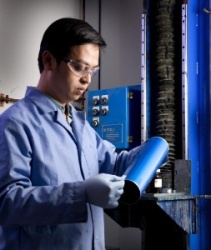Nov 13 2009
New “super coating” hints at how smart materials, nanotechnology will influence future design of office and production products
Tasked with developing ways to extend the lifespan of printer components – and reduce their impact on the environment – a group of scientists at Xerox Corporation (NYSE:XRX) have developed a new chemical armor that protects photoreceptors, the light-sensitive elements in xerographic machines. Protected from normal wear and tear, a photoreceptor coated with the new “armor” can survive more than one million revolutions – nearly doubling its usable life.
 Kenny Dinh, lab manager, Xerographic Component Systems Group in Webster, N.Y. inspects a photoreceptor drum after applying the protective chemical armor with a coating machine
Kenny Dinh, lab manager, Xerographic Component Systems Group in Webster, N.Y. inspects a photoreceptor drum after applying the protective chemical armor with a coating machine
“The long life of the photoreceptor reduces the need for replacement cartridges, enabling a 33 percent reduction in waste,” said Yonn Rasmussen, vice president of the Xerographic Component Systems Group. “Customers experience less down time, and therefore reduced interruptions to work flow, improved productivity, and fewer service calls.”
Photoreceptors are multi-layer thin film devices that convert light into electrostatic images. They must be replaced periodically due to surface wear and scratches that can affect image quality.
“This novel long life overcoat is an example of cutting-edge chemistry at work that required both materials and process innovation,” said Giuseppa DiPaola-Baranyi, laboratory manager for Materials Integration at the Xerox Research Centre of Canada. “The ultimate goal is to develop photoreceptors that will last the entire life of the machine. For example, when you scratch your hand and you heal, that’s a biological process. We are looking at how to mimic nature and leverage our expertise in smart materials design and nanotechnology to create molecules for next-generation photoreceptors with self-healing capabilities.”
The new photoreceptor works in the standard machine design with no additional hardware changes or added costs to the customer. This invention has broad applicability across Xerox’s product portfolio and is being first implemented in the Xerox 4112™/4127™ light production monochrome printers.
A global, multi-disciplinary team from the Xerox Research Centre of Canada, the Xerographic Component Systems Group engineering team in Webster, N.Y. and the manufacturing team in Venray, The Netherlands, advanced the project from the pilot plant stage in Canada to production in Venray in less than one year, a record time for commercializing a new technology such as this.